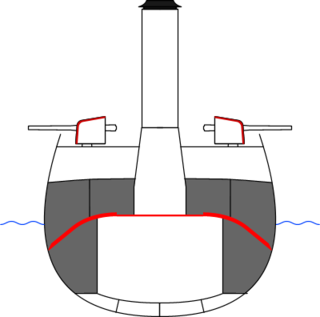
The protected cruiser is a type of naval cruiser of the late 19th century, so known because its armoured deck offered protection for vital machine spaces from fragments caused by exploding shells above. Protected cruisers are similar to armoured cruisers, which also had a belt of armour along the sides.

The New Orleans class of protected cruisers of the United States Navy consisted of two ships which were building for the Brazilian Navy at Elswick, near Newcastle Upon Tyne, England, by Armstrong Whitworth. The Brazilian Navy had ordered four Elswick cruisers, but had already sold the first ship during construction to Chile as Ministro Zenteno. One ship was delivered to Brazil, named Almirante Barroso. The third ship was fitting out as Amazonas, and the fourth was on order as Almirante Abreu.

Yoshino (吉野) was a protected cruiser of the Imperial Japanese Navy. Yoshino is sometimes regarded as a sister ship to Takasago, although the two vessels are of different classes. The name Yoshino comes from the Yoshino mountains, located in the southern portion of Nara prefecture. She played an important role in the First Sino-Japanese War, but was sunk in the Russo-Japanese War after being rammed by Japanese armored cruiser Kasuga in dense fog.

Naniwa (浪速) was the lead ship of the Naniwa-class protected cruisers, built in the Newcastle upon Tyne-based Armstrong Whitworth Elswick shipyard in the United Kingdom. Together with her sister ship, Takachiho, these were the first protected cruisers acquired by the Imperial Japanese Navy. The name Naniwa comes from an ancient name for Osaka, which appears in the Nara period chronicle Nihon Shoki. She played a major role in the First Sino-Japanese War of 1894–95.
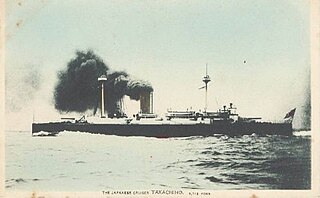
Takachiho (高千穂) was the second and final Naniwa-class protected cruiser built for the Imperial Japanese Navy by the Newcastle upon Tyne-based Armstrong Whitworth Elswick shipyard in the United Kingdom. The name Takachiho comes from a mountain in the volcanic Kirishima range between Kagoshima and Miyazaki prefectures in Japan, which was a prominent location in Japanese mythology. Takachiho played a major role in the First Sino-Japanese War of 1894–1895, but was lost in combat in World War I.

Takasago was a protected cruiser of the Imperial Japanese Navy, designed and built by the Armstrong Whitworth shipyards in Elswick, in the United Kingdom. The name Takasago derives from a location in Hyōgo Prefecture, near Kobe.
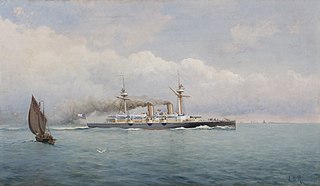
Izumi (和泉) was a protected cruiser of the Imperial Japanese Navy, designed and built by the Newcastle upon Tyne-based Armstrong Whitworth shipyards at Elswick in the United Kingdom for the Chilean Navy. Its first name was Esmeralda before it was sold to Japan in 1894. Its Japanese name is also sometimes (archaically) transliterated as Idzumi, and refers to ancient Izumi Province, now part of Osaka-fu. During its time in service it participated in the Panama crisis of 1885 asserting Chilean interests, the 1891 Chilean Civil War, the suppression of the Boxer Rebellion, and the Russo-Japanese War.
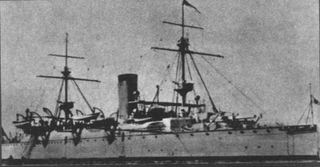
The two Naniwa-class cruisers were protected cruisers operated by the Imperial Japanese Navy. Both participated in numerous actions during the First Sino-Japanese War and in the Russo-Japanese War.

Isla de Cuba was an Isla de Luzón-class second-class protected cruiser of the Spanish Navy which fought in the Battle of Manila Bay.

The Giuseppe Garibaldi-class cruisers were a class of ten armoured cruisers built in Italy in the 1890s and the first decade of the 20th century. The ships were built for both the Royal Italian Navy and for export.

Giovanni Bausan was a protected cruiser of the Italian Regia Marina that was designed and built by Sir W G Armstrong Mitchell & Co.'s Elswick Works in England in the mid-1880s. The finished ship entered service in May 1885. She was the first ship of this type to be built for the Italian fleet, and she provided the basis for subsequent designs built in Italy, including the Etna class. Giovanni Bausan was intended to serve as a "battleship destroyer", and was armed with a main battery of two 10-inch (254 mm) guns to give her the ability to defeat heavy armor, but design flaws rendered her unfit for this role.

ARA Almirante Brown was a central battery ironclad of the Argentine Navy built in the 1880s by Samuda Brothers in London. Almirante Brown displaced 4,200 long tons (4,300 t) and had a top speed of 14 knots. The ship was protected by a belt of nine-inch (230 mm) steel-faced armor and she carried a main battery of eight breech-loading guns. She was among the first major warships in the world to use steel armor, and remained the largest vessel in the Argentine fleet for over 15 years. Almirante Brown had a peaceful career in the fleet during the 1880s and 1890s. By the 1920s, she was reduced to a coastal defense ship, and remained in service until the early 1930s. She was stricken from the naval register in November 1932 and sold for scrapping.
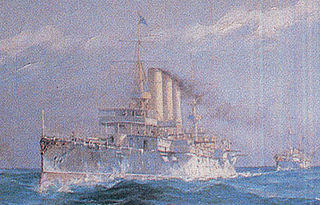
O'Higgins was a Chilean armoured cruiser. O'Higgins was built by the British shipbuilder Armstrong to the design of Philip Watts, and served with the Chilean Navy between 1898 and 1933.

In the late nineteenth and early twentieth centuries, the South American nations of Argentina and Chile engaged in an expensive naval arms race to ensure the other would not gain supremacy in the Southern Cone.

Ministro Zenteno was a protected cruiser of the Chilean Navy.

ARA Buenos Aires was a protected cruiser of the Argentine Navy. It was built by the British shipyard of Armstrong Mitchell and Co, being launched in 1895 and completing in 1896. Buenos Aires continued in use until 1932.

Dogali was a unique protected cruiser built for the Italian Regia Marina in the 1880s. Notably, she was the first warship equipped with triple-expansion engines. The ship was originally ordered by the Greek Navy and named Salamis, but she was sold to the Regia Marina before she was completed and renamed for the Battle of Dogali. She was armed with a main battery of six 15-centimeter (5.9 in) guns and reached a speed of 19.66 knots on her sea trials, making her one of the fastest cruisers at the time.
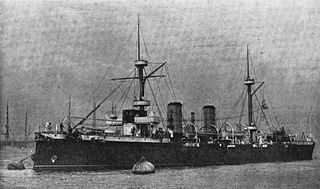
ARA Veinticinco de Mayo was a protected cruiser that served in the Argentine Navy between 1891 and 1921.

ARA Libertad was a battleship that served in the Argentine Navy between 1892 and 1947, and with the Argentine Coast Guard as a pilot station ship from 1947 to 1968. It was the seventh Argentine naval ship with this name.

The Rosario-class gunboats were a class of two pre-World War I warships, designed and built in England in 1907–1909 as armoured riverine gunboats, to patrol the rivers Paraná and Uruguay. They were in service with the Argentine Navy from the late 1900s to the early 1950s. The lead ship of the class was named after Rosario, one of the major cities in Argentina.



















